Fresh off a public hearing dominated by opposition to their I-5 Rose Quarter project, the Oregon Department of Transportation (ODOT) is now hearing new concerns from the Portland Public Schools Board.
In addition, the leader of the Albina Vision project, Rukaiyah Adams, made public statements about the project at an event hosted by the Portland Parks Foundation last night. And No More Freeways PDX has filed a formal request for an extension to the current comment period for the project’s Environment Assessment on grounds that ODOT withheld crucial data and gave the community only 18 days to analyze it.
Here’s a rundown on each of those fronts…
The big news was reported by The Oregonian late today. According to their story the PPS Board will ask ODOT to do a full Environmental Impact Statement — a much more rigorous undertaking than an Environmental Assessment (both of which are requirements under the federal National Environmental Policy Act (NEPA) process).
The O says, “The district’s concerns mirror those the community at large has expressed about the interstate project,” that ODOT hasn’t given them enough time to evaluate the EA, and that both ODOT and the Portland Bureau of Transportation have failed to fully engage with them about the myriad issues surrounding Harriet Tubman Middle School.
The full PPS Board is due to vote on whether or not they should formally request an EIS at their meeting tonight (6:00 pm, details and agenda here).
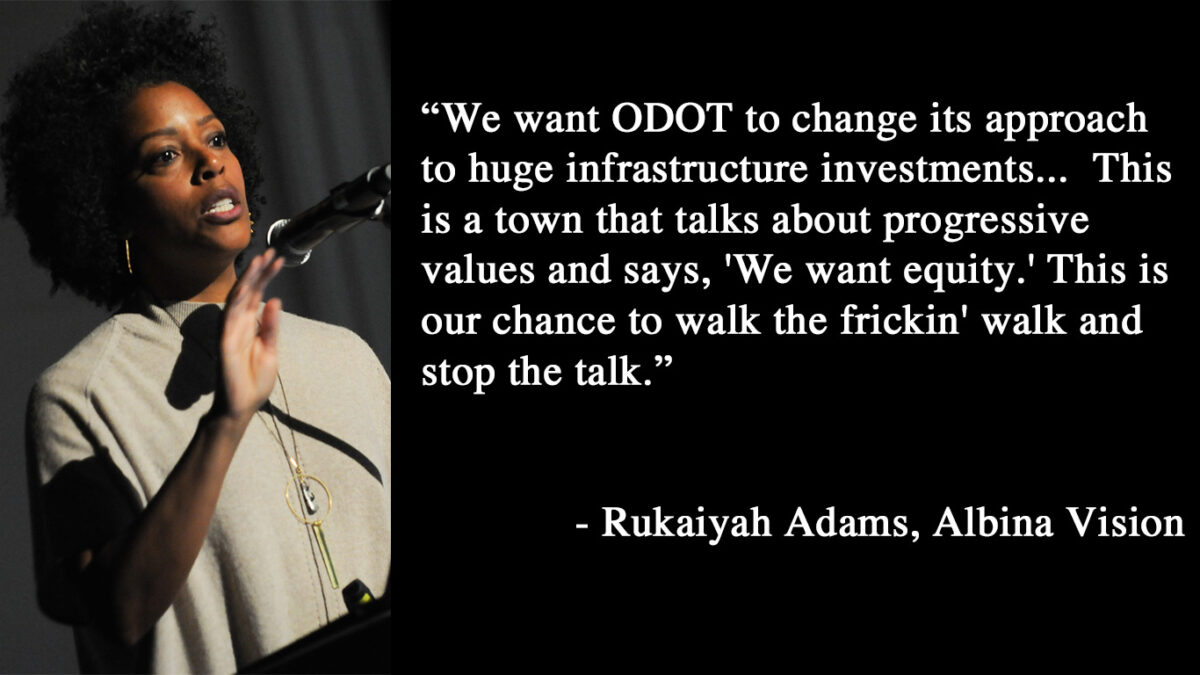
(Photo: Jonathan Maus/BikePortland)
ODOT’s I-5 project was also under a microscope at an event last night hosted by the Portland Parks Foundation. There were speakers and a panel to discuss how the project might be an opportunity to create world-class parks and urban spaces. The I-5 Rose Quarter project was paired with Albina Vision (we shared how these projects overlap a few weeks ago). As Chief Investment Officer for Meyer Memorial Trust and a well-respected community leader, Rukaiyah Adams pulls a lot of weight. As leader and chief spokesperson for Albina Vision, she finds herself in an interesting position of influence on the I-5 project.
Adams made several statements last night worth noting (also worth noting is that ODOT Region 1 Director Rian Windsheimer, Commissioner Chloe Eudaly’s Chief of Staff Marshall Runkel, Metro President Lynn Peterson (sitting next to Windsheimer), Multnomah County Commissioner Jessica Vega Pederson, and others were in attendance):
Advertisement
As Adams laid out her group’s plans for restoring the Albina neighborhood that was destroyed by I-5 and other Rose Quarter developments, she said, “We want ODOT to change its approach to huge infrastructure investments like the ones we make with I-5.”
Later in the evening, Adams asked another panelist, a megaproject manager from Washington’s Department of Transportation, about how they were able to make progress on massive infrastructure projects:
“One of the points the Albina Vision team is trying to make is that the evaluation of impact on the community shouldn’t just be the community that’s there today, but the historic community impact. It sounds like you thought of that and you ran an EIS process, which is the more comprehensive evaluation than an EA process. So I wanted to know why you went to an EIS process instead of the faster EA process.”
Then Adams was asked to respond to a question from the audience. Someone asked: “Can you imagine a future for the Albina Vision that is not dependent on widening the freeway?” “Yes. I can envision a future like that,” Adams replied (and the audience began clapping). She then turned to ODOT I-5 Rose Quarter Project Manager Megan Channell and said, “Megan, I’m sorry.”
“Let’s say this project doesn’t come to pass,” Adams continued. “We still have the [freeway] cap question, to stitch the neighborhoods back together. From our point-of-view, the question of, ‘How do you heal this gash that we’ve cut into the city.’… The context is this project, but it’s not limited to the project.”
When asked to consider the future of the Rose Quarter more broadly, given that several major properties have uncertain futures, Adams got real. “Here’s the rub: This is a town that talks about progressive values and says, ‘We want equity.’ This is our chance to walk the frickin’ walk and stop the talk…. We have thousands of people needing affordable housing and this is 94 acres in the central city… I think we should design our processes and outcomes for the people who live here. I want the city to work for the people. And we’re not backing down.”
On that note, No More Freeways PDX has made a formal request for 45 more days to comment on the EA. The coalition leading the charge against the I-5 Rose Quarter project says 632 pages of technical analysis and datasets were only made available on March 13th — nine days after it was requested. “Without these data,” their letter reads, “it is simply impossible to independently assess ODOT’s claims about how this freeway expansion will impact the local community.”
— Jonathan Maus: (503) 706-8804, @jonathan_maus on Twitter and jonathan@bikeportland.org
Never miss a story. Sign-up for the daily BP Headlines email.
BikePortland needs your support.


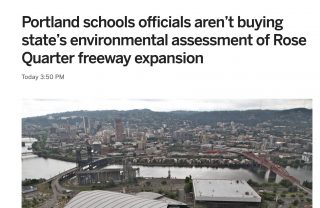

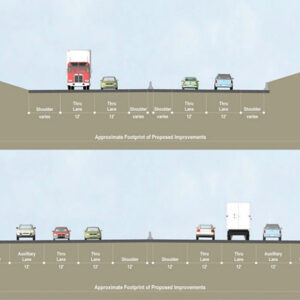
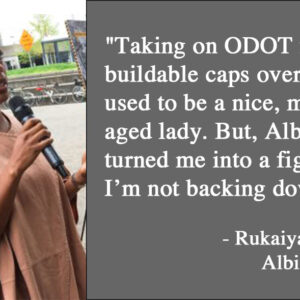
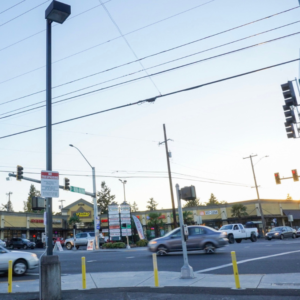
Thanks for reading.
BikePortland has served this community with independent community journalism since 2005. We rely on subscriptions from readers like you to survive. Your financial support is vital in keeping this valuable resource alive and well.
Please subscribe today to strengthen and expand our work.
what…PPS is actually doing/saying something..wait a minute they can’t even care for there own buildings, but somehow always give themselves and admins raises…
Institutions evolve…I remember when it was pretty common for our regional transit agencies to only care about the number of buses they moved and not the number of passengers [who had a good trip etc.] So PPS may be in the a similar transition from moving from counting “bandages” distributed to new measures of success like patients healed (outcomes based approach).
Wow, great coverage! I hope the air quality issues are included in the EA “data”.
>>> I think we should design our processes and outcomes for the people who live here. I want the city to work for the people. <<<
"The people" probably want "congestion relief," and, I suspect, would support this project. I'd be happy to be proved wrong, and I am happy at the growing opposition to this project from some non-traditional quarters.
Who are “the people” exactly? Those (mostly black people) who lived there 20-40 years ago who were involved with the Albina Community Plan but who have since been displaced by gentrification, either to East Portland or outside the city altogether, neither of which are part of the PPSD? Or the newer folks who have since moved in and can afford to live there?
70% of kids at Tubman are kids of color, and 40% are black. Just because these kids and families are invisible to you doesn’t mean many of them aren’t still here.
So how many kids is that – a couple of dozen?
If you want to know the real answer, it is here:
https://www.pps.net/cms/lib/OR01913224/Centricity/Domain/207/Enrollment%20by%20Race%20and%20School%202018-19.pdf
Given those demographics, the photo used in this story is striking:
https://bikeportland.org/2019/02/01/tubman-middle-school-parents-meet-school-and-city-staff-to-discuss-traffic-safety-issues-294880
Thanks for posting the numbers, that was a fun read I love to see the make up of all the neighborhoods.
As far as the representation in the photos, that is a pretty common sight. I’m not an expert, but I believe this sort of meeting representation skews more overtly along socio-economic status than race. If you are working a stable mid-range professional level 9-5 job it is much easier to make meetings at weird times, or duck out of work a few min. early for a meeting after school.
I have that advantage (but no kids). However in my own experience there are a number of bike related meetings I can’t make because the city schedules hearings at some of the least workable times on earth, and I generally come and go as I please at work!!
It is often the case, in Portland and everywhere, that race and socioeconomic status are aligned.
It’s worth remembering that the averages belie huge wealth disparities and inequity among white people.
Did you know you can’t always tell the race of the kid by looking at their parents?
It’s also the case that white parents tend to have more capacity for evening meetings, volunteering, etc., because they are generally wealthier. The Tubman PTSA has black leadership and involvement from a range of families, and Tubman has black administrators, too.
Though I usually find your comments — like this one — offputting, I admire your energy in ceaselessly championing conservative causes in this unreceptive forum.
I suspect there is more diversity in thought amongst the readers than the loudest and most frequent voices suggest. I, for one, let a lot of comments that I think are frikin’ nuts wash on by. People, you included, should be allowed to express their opinions in the public space, but responding with this kind of snark doesn’t really add much to the conversation.
As of the fall, Tubman had 199 black kids, 73 Latino kids, 40 Asian kids, 8 Native American kids, 2 Pacific Islander kids, some multiracial kids, and 154 white kids. It’s a majority-minority school.
“The people want congestion relief” Even if this project was about congestion relief, which even ODOT says it isn’t, of course “the people” want congestion relief. They also want cheap health care, lower taxes, less people living on the streets, fewer potholes…. and everything else under the sun. “The people” also largely don’t want to pay for these things and don’t have any good ideas on how to implement them.
The average person thinks if we just used our transportation dollars to build more lanes congestion would disappear and there’s no need to increase tax revenue we just need to spend money on expansion instead of bike lanes cause those things cost the same.
The fuel tax money only accounts for 20% of the cash involved in paying for freeways, street and Highway maintenance. The rest is derived from income and property taxes. Yes the motorists and truckers do pay for the fuel taxes but their usage accounts for 95% of the destruction of the same facilities aside from water and gas line breaks. Bicyclists and pedestrians just don’t destroy the roads like motorists do.
ODOT and the commercial truckers would be very happy with 65 MPH speed limits through town on surface streets. The destruction I would see on streets like Gleason through NW Portland would be pure carnage with delivery trucks parked loading and unloading every other block in the traffic lanes with everyone driving at freeway speeds.
It is the basic Motorist mentality that ODOT and PBOT is stuck with.
Do you have a source for the notion that 80% of street maintenance comes from income and property taxes? I’ve seen data, posted to another thread recently, that suggests there is some, but not much, non-vehicular funding (fuel tax plus various other fees, taxes, and charges) involved in building and maintaining roads.
Can you post data for this “some, but not much” non-vehicular funding? The thread in which we engaged last time was unclear but showed perhaps half non-vehicular funding.
See https://bikeportland.org/2019/03/11/the-monday-roundup-speed-limiters-in-eu-porn-pedallers-progress-in-seattle-and-more-296796. My comment at 12:06 lays out my data, sources, and uses numbers from this year.
Your comment also includes “vehicle sources” we all pay for regardless of how much we drive. Considering most of our infrastructure is for commuters that drive it’s a pretty dishonest interpretation. Jim don’t be mislead by the idea that a person that drives to work pays more for milk delivered to you then if you don’t drive.
I was responding to this comment:
>>> The fuel tax money only accounts for 20% of the cash involved in paying for freeways, street and Highway maintenance. The rest is derived from income and property taxes. <<<
I think my numbers clearly refute this idea, and are not dishonest at all. That some portion of the highways are paid for by vehicle fees not related to distance driven is simply not relevant.
Oh no it is very relevant. We’re discussing peoples use of our roads. So how much they use them to commute is quite important. You trying to whitewash all that use under commercial interests is dishonest. Our transportation system would be much smaller and cheaper if it only serviced transit and commercial interests. The drivers that aren’t a part of those groups are being subsidized.
Please stop trying to twist things so that it looks like people who choose to drive are the same as commercial interests. It’s very dishonest.
In most states, what you write is true, but not necessarily in Oregon. The City of Portland uses some, but not a lot, of property tax money for city streets, but only during surplus years. The state doesn’t collect property taxes for transportation nor do the counties (but they do collect it for other purposes, schools for example.) Most transportation revenue in Oregon is gas tax, vehicle fees and taxes, weight mileage taxes, etc. which cannot be used for anything other than transportation improvements. Again, Oregon is unique in this respect – all other states mix those taxes with other revenues into a giant pot, which can be used for anything from schools, to housing, to the homeless, to prisons, and yes, to even build massive freeways.
South Carolina and Oregon both have about 4 million people, but because SC can mix revenue sources, their highway fund is much larger, while their area they have to cover is obviously a small fraction of Oregon’s, with no mountain to speak of, aside from egos.
What odot doesn’t want is for albina to wake up to the fact it was sold once for a freeway and now they want to sell it twice for an even bigger discount.
I’m pretty sure historic Albina has been aware of this for much longer than you have!
I was at the Parks foundation presentation. Rukaiyah Adams presented a very compelling vision for a future evolution of the Rose Quarter. ODOT’s proposal is largely at odds withthat vision because the caps are designed for temporary staging and not urban development. They are too small to effectively block the noise and pollution of the freeway below, and not designed to support buildings. ODOT’s caps will provide more space for bigger faster surface streets with wider, faster ramps on to the freeway overs a bigger, louder more polluting freeway. Will Ives gave a brief urban design presentation that basically confirmed that the ODOT plan of small lids with no buildings will yield unprogrammable urban voids, and even with buildings, the leftover spaces or small and awkward. That is because they are designed as minimal lids to provide staging area- they are not intended to make great or even functional urban spaces. Julie Meredith (WDOT) talked about the many lids over freeways that have been built in Washington. I found this to be a quiet condemnation of ODOT’s process and design. Washington has found success with there lids by inviting strong participation from the surrounding communities and integrating bikes, peds and transit. ODOT is merely trying to repurpose some flimsy lids they would have to build regardless for staging, trying to greenwash them to sell them as urban amenities. If ODOT (or Portland) were serious about using this project to address urban design issues, the project would start on the surface. The lid would be designed to create necessary connections and functional, well-programmed spaces. The surface streets would be designed for the local needs and for safety. Then the transit needs would be considered and integrated with the surface transportation. Finally, the freeway would be designed to flow under the proposed lid which would be much larger, have buildings of some sort on it, and possibly would not include ramps to or from the freeway. The connection at Flint would be recreated, and the Clackamas crossing would part of the City instead of a skinny ribbon climbing and snaking along above the freeway.
Post of the week!
WashDOT’s lids were far better than the planned construction-staging bits we’re presented with, but I’m still unimpressed. Remember the meandering paths through grassy space? That does not suggest transportation to me. At least they require restoration of the grid.
Well said! If we started from the surface streets, truly involved the local community and considered the Albina Vision, we’d have a much different project on our hands.
thanks maxD. Flagging this for comment of the week.
The problem with the freeway, as it currently exists, is that the ramps are spaced too closely together, creating unsafe merging conditions. There are two potential solutions:
1) Add auxiliary lanes.
2) Remove some of the ramps.
So far, I haven’t seen any evidence that ODOT even considered the second option. The obvious solution is to remove the Broadway/Weidler exits (all four of them). This would solve the merging issue. The merging lanes could be lengthened a bit, but full auxiliary lanes wouldn’t be necessary. Traffic accessing the Pearl district would use the Fremont bridge. Traffic going to the Lloyd district would have to use the Alberta St. and Morrison St. exits. This is, admittedly, a bit of a stretch for southbound traffic. So instead, I propose that ODOT add ramps from MLK to the I-84-to-I-5 NB onramp, and from the I-5-to-I-84 SB offramp to MLK (immediately south of the convention center). The offramp from the NB ramp to Holladay St. would be closed. This space is already a dead zone thanks to I-84, and from ODOT’s perspective it’s a good solution since it delivers traffic directly to major arterials (MLK/Grand). Estimated cost? $50 million? That would leave a solid chunk of money left over for neighborhood improvements.
Thoughts?
Having driven through this area, in a motor vehicle, it always seemed to me that there were too many ramps. I’ve never done a proposal but it almost seems things could be improved with dice rolls. I’ll take a longer look at your suggestions. Thanks!
Failing to consider a reasonable alternative in the EA can be grounds for throwing it out in a legal challenge, but only if raised during the public comment period. I strongly suggest you make that comment on the docket.
I can confirm ODOT did not seriously consider options because during the process we submitted those ideas and they were removed from consideration as “out of scope” or with no real defined reason for excluding those proposals from the process.
(1) removing on/off ramps
[ODOT claims the main issue that causes fender benders is all the ‘weaving’ – this would be an easy and low cost option for managing the weaving issue]
(2) protem ramps
[How about we only open certain ramps during events or during rush hour?]
The reason they pushed these ideas aside seems to be because ODOT wanted to build a highway widening project and this was their opportunity to do so. Any consideration to no build, prorated, less ramps, different designs that don’t include lots of ramps and additional lanes were non starters for ODOT.
That public process was truly a sham.
Really excited to suppprt Adam’s leadership when she is actively questioning ODOT’s rational for bundling the Albina Vision with a Freeway widening. Freeways were part of the original problem and more of the same is not going to fix historic racism and redlining. We support Adams line of questioning. We can build Albina without the freeway widening. Please push this conversation with ODOT’s personal.
Have you seen the latest ODOT ploy? Put a “cap” on it, and build parks, communities, etc., on top of the cap? How much will this add to the cost? And, have you ever driven through a capped freeway choked with exhaust fumes and no ventilation? This stuff gets more absurd by the hour. I’ve had it.
That has always been part of the project.
“the ramps are spaced too closely together, creating unsafe merging conditions”
Is this actually the case? I’ve merged here from the northbound lane to the Weidler exit thousands of times and have never felt like I was in danger. How many people are injured here annually?
Should be nested under Jonathan K’s post.
Road funding by user fees:
https://taxfoundation.org/state-road-funding-2017/
Once again, user fees that pale in comparison to driving subsidies.
That page provides essentially zero information. Where does the rest of the money come from?
I have ridden this section of highway, on a motorcycle and it’s a meat grinder. If I am in the mood to feel like TRON, it’s great. But when I sit back and realize my mortality, it’s a bad place to be any other time than a sunny day at noon. And yes, too many ramps. The whole area is a moving mess. ODOT’s solution? Add more cars and more chaos. Why? Because this is a the catalyst they need to widen the rest of the highway from Lombard to the 405 merge. Make no mistake, there are powerful voices within ODOT that feel that their work was undone from years ago. They want a Houston in the Portland core and won’t stop until they die, retire or get their vision.
The time to stand firm is now.